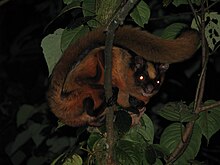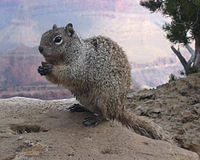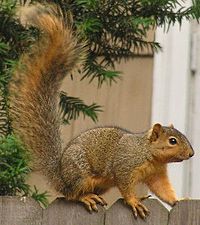Bhutan giant flying squirrel
| Bhutan Giant Flying Squirrel | |
|---|---|
 | |
| In Sikkim, India | |
Conservation status | |
| Scientific classification | |
| Domain: | Eukaryota |
| Kingdom: | Animalia |
| Phylum: | Chordata |
| Class: | Mammalia |
| Order: | Rodentia |
| Family: | Sciuridae |
| Genus: | Petaurista |
| Species: | P. nobilis |
| Binomial name | |
| Petaurista nobilis (J. E. Gray, 1842) | |
 | |
| Range in red | |
The Bhutan giant flying squirrel (Petaurista nobilis), also known as the Gray's giant flying squirrel or noble giant flying squirrel, is a species of rodent in the family Sciuridae.[1] This species lives in Himalayan forests and it is one of the largest flying squirrels. Like other flying squirrels, it is mainly nocturnal and able to glide (not actually fly like a bat) long distances between trees by spreading out its patagium, skin between its limbs.[2][3]
Distribution
The Bhutan giant flying squirrel has a narrow range in the Himalayas where restricted to central and eastern Nepal, Bhutan, and the Indian states of Sikkim, far northern West Bengal, and western and central Arunachal Pradesh.[1][2][4][5][6] It might occur in Tibet in China, but this remains unconfirmed.[1]
Appearance and taxonomy

The Bhutan giant flying squirrel is one of the largest flying squirrels with a head-and-body length of about 35–69 cm (1 ft 2 in – 2 ft 3 in), a tail length of 38–61.5 cm (1 ft 3 in – 2 ft 0 in) and a total length of up to c. 127 cm (4 ft 2 in).[2][6] There are some variations in the proportions; some individuals have a longer tail than the head-and-body, but it is shorter in others.[6] An individual that had a head-and-body length of 49 cm (1 ft 7 in) and a tail length of 46 cm (1 ft 6 in) weighed 2,710 g (5.97 lb).[3] There are two subspecies: the western P. n. nobilis (Nepal, Sikkim and West Bengal) and eastern P. n. singhei (Bhutan and Arunachal Pradesh).[6][7][8][9] The latter is generally larger and with a thicker pelage than the former.[6][9]
The shoulders of the Bhutan giant flying squirrel are yellowish-buff or orange-buff and this colour extends along the flanks, bordering and clearly contrasting with the rich chestnut-brown or maroon-brown back ("saddle").[2][9] Although the saddle appears overall dark, some of the hairs have yellowish tips.[2][3] In some individuals, the light colour of the shoulders and flanks extends even further to the posterior and join on the lowermost back, almost completely encircling the dark saddle.[6] The top of the head is dark and often connected by a dark thin line or broad patch to the dark saddle.[6] There is a distinct pale fulvous or orange-buff band/patch on the crown (making the dark top of the head appear rather like a bandit mask),[3][10] although this band/patch occasionally is poorly defined or entirely absent in P. n. nobilis.[9] Most P. n. nobilis have a distinct buff stripe along the mid-back (dividing the dark "saddle"), but it is occasionally incomplete or even absent. Most P. n. singhei lack this stripe and when present it is incomplete.[8][9] The underside of the Bhutan giant flying squirrel is uniformly coloured light pale rufous, salmon-buff or ochre, and the patagium is orange-rufous.[3][9] The orange-rufous tail has a black tip,[10] and the limbs are orange-rufous, often with black fingers/toes.[9] Overall, P. n. singhei is more richly coloured than P. n. nobilis.[6]
Confusion with Hodgson's giant flying squirrel

Despite already being scientifically described by John Edward Gray in 1842, the Bhutan giant flying squirrel has often been confused with the Hodgson's giant flying squirrel (Petaurista magnificus), which is found in the same general region. In 1863, Edward Blyth considered the Bhutan giant flying squirrel as a synonym of the Hodgson's giant flying squirrel.[11]
Many—but not all—later sources followed this, and William Thomas Blanford considered the two as seasonal variants of one species, with the Bhutan giant flying squirrel being the "summer form" and the Hodgson's giant flying squirrel being the "winter form". This was repeated by others, even authorities with access to museum specimens showing that neither colour pattern is restricted to a specific season.[9] The situation was further confused by mislabeled museum specimens, including a misidentified Bhutan giant flying squirrel that was recognised as a paratype for the Hodgson's giant flying squirrel in 1918.[9]
Only in the late 1970s and early 1980s was it firmly established that the two species differ both in their colour patterns and size.[8][9] In addition to its smaller average size (although its tail may be longer) and differences in the skull, the Hodgson's giant flying squirrel has large yellowish-buff shoulder patches that contrast with the deep russet or chestnut flanks, lacks a light stripe along the mid-back, and the light patch on the crown—if present at all—only consists of a spot that occasionally forms a streak.[2][9][12]
Habitat and behavior
The natural habitats of the Bhutan giant flying squirrel are subtropical forests, temperate broadleaf forests, rhododendron forests and coniferous forests.[1][4][10] Although mostly found between 1,500 and 3,000 m (4,900–9,800 ft) elevation,[1][2][10] it has been recorded down to 800 m (2,600 ft).[5]
Little is known about the behavior of the Bhutan giant flying squirrel. It is mostly nocturnal like other flying squirrels, but the species has also been seen at dawn and dusk.[3] The Bhutan giant flying squirrel appears to breed in March and April.[2] Although it generally lives in trees, it has been seen feeding on the ground.[6]
Conservation status
The Bhutan giant flying squirrel is mainly threatened by habitat loss and degradation. To a lesser degree it is threatened by hunting for bushmeat and its pelt, and capture for the local pet trade.[1][4][5] The IUCN recognises the species as near threatened, but almost qualifying for vulnerable. It occurs in several reserves.[1]
References
- ^ a b c d e f g h Molur, S. (2016). "Petaurista nobilis". IUCN Red List of Threatened Species. 2016: e.T16722A22271710. doi:10.2305/IUCN.UK.2016-3.RLTS.T16722A22271710.en. Retrieved 13 November 2021.
- ^ a b c d e f g h Jackson, S.M. (2012). Gliding Mammals of the World. CSIRO Publishing. pp. 112–135. ISBN 9780643092600.
- ^ a b c d e f Thorington, R. W. Jr.; Koprowski, J.L.; Steele, M.A.; Whatton, J.F. (2012). Squirrels of the World. Baltimore: Johns Hopkins University Press. p. 116. ISBN 978-1-4214-0469-1.
- ^ a b c Thapa, S.; H.B. Katuwal; S. Koirala; B.V. Dahal; B. Devkota; R. Rana; H. Dhakal; R. Karki; H. Basnet (2016). Sciuridae (Order: Rodentia) in Nepal. Small Mammals Conservation and Research Foundation, Kathmandu, Nepal. pp. 24–26.
- ^ a b c Krishna, M.C.; A. Kumar; O.P. Tripathi; J.L. Koprowski (2016). "Diversity, Distribution and Status of Gliding Squirrels in Protected and Non-protected Areas of the Eastern Himalayas in India". Hystrix: The Italian Journal of Mammalogy. 27 (2): 1–9. doi:10.4404/hystrix-27.2-11688.
- ^ a b c d e f g h i Choudhury, A. (2002). "Petaurista nobilis singhei: First record in India and a note on its taxonomy". The Journal of the Bombay Natural History Society. 99 (1): 30–34.
- ^ Thorington, R.W. Jr; Hoffman, R.S. (2005). "Species Petaurista nobilis". In Wilson, D.E.; Reeder, D.M (eds.). Mammal Species of the World: A Taxonomic and Geographic Reference (3rd ed.). Johns Hopkins University Press. pp. 754–818. ISBN 978-0-8018-8221-0. OCLC 62265494.
- ^ a b c Saha, S. S. (1977). "A new subspecies of the flying squirrel, Petaurista nobilis (Gray), from Bhutan". Proc. Zool. Soc., Calcutta. 28 (1): 27–29.
- ^ a b c d e f g h i j k Ghose, R.K.; Saha, S. S. (1981). "Taxonomic review of Hodgson's giant flying squirrel, Petaurista magnificus (Hodgson) (Sciuridae: Rodentia), with description of a new subspecies from Darjeeling District, West Bengal, India". The Journal of the Bombay Natural History Society. 78 (1): 93–102.
- ^ a b c d Koli, V.K. (2016). "Biology and Conservation Status of Flying Squirrels (Pteromyini, Sciuridae, Rodentia) in India: An Update and Review". Proc Zool Soc. 69 (1): 9–21. doi:10.1007/s12595-015-0141-z. S2CID 17281646.
- ^ Jackson, S. M.; Thorington, R. W. Jr. (2012). "Gliding Mammals – Taxonomy of Living and Extinct Species". Smithsonian Contributions to Zoology. 638 (638): 1–117. doi:10.5479/si.00810282.638.1.
- ^ Menon, V. (2014). Indian Mammals. Hachette Book Publishing. ISBN 978-93-5009-760-1.
- v
- t
- e
- Kingdom: Animalia
- Phylum: Chordata
- Class: Mammalia
- Order: Rodentia
- Suborder: Sciuromorpha
- Groove-toothed flying squirrel (Aeretes melanopterus)



(Large black flying squirrels)
- Black flying squirrel (Aeromys tephromelas)
- Thomas's flying squirrel (Aeromys thomasi)
- Hairy-footed flying squirrel (Belomys pearsonii)
- Namdapha flying squirrel (Biswamoyopterus biswasi)
- Mount Gaoligong flying squirrel (Biswamoyopterus gaoligongensis)
- Laotian giant flying squirrel (Biswamoyopterus laoensis)
- Kashmir flying squirrel (Eoglaucomys fimbriatus)
- Western woolly flying squirrel (Eupetaurus cinereus)
- Yunnan woolly flying squirrel (Eupetaurus nivamons)
- Tibetan woolly flying squirrel (Eupetaurus tibetensis)
(New World flying squirrels)
- Humboldt's flying squirrel (Glaucomys oregonensis)
- Northern flying squirrel (Glaucomys sabrinus)
- Southern flying squirrel (Glaucomys volans)
- Particolored flying squirrel (Hylopetes alboniger)
- Bartel's flying squirrel (Hylopetes bartelsi)
- Hainan flying squirrel (Hylopetes electilis)
- Palawan flying squirrel (Hylopetes nigripes)
- Indochinese flying squirrel (Hylopetes phayrei)
- Jentink's flying squirrel (Hylopetes platyurus)
- Arrow flying squirrel (Hylopetes sagitta)
- Sipora flying squirrel (Hylopetes sipora)
- Red-cheeked flying squirrel (Hylopetes spadiceus)
- Sumatran flying squirrel (Hylopetes winstoni)
- Javanese flying squirrel (Iomys horsfieldi)
- Mentawi flying squirrel (Iomys sipora)
(Pygmy flying squirrels)
- Lesser pygmy flying squirrel (Petaurillus emiliae)
- Hose's pygmy flying squirrel (Petaurillus hosei)
- Selangor pygmy flying squirrel (Petaurillus kinlochii)
- Red and white giant flying squirrel (Petaurista alborufus)
- Spotted giant flying squirrel (Petaurista elegans)
- Japanese giant flying squirrel (Petaurista leucogenys)
- Hodgson's giant flying squirrel (Petaurista magnificus)
- Mechuka giant flying squirrel (Petaurista mechukaensis)
- Mishmi giant flying squirrel (Petaurista mishmiensis)
- Bhutan giant flying squirrel (Petaurista nobilis)
- Red giant flying squirrel (Petaurista petaurista)
- Indian giant flying squirrel (Petaurista philippensis)
- Mebo giant flying squirrel (Petaurista siangensis)
- Chinese giant flying squirrel (Petaurista xanthotis)
- Basilan flying squirrel (Petinomys crinitus)
- Travancore flying squirrel (Petinomys fuscocapillus)
- Whiskered flying squirrel (Petinomys genibarbis)
- Hagen's flying squirrel (Petinomys hageni)
- Siberut flying squirrel (Petinomys lugens)
- Mindanao flying squirrel (Petinomys mindanensis)
- Arrow flying squirrel (Petinomys sagitta)
- Temminck's flying squirrel (Petinomys setosus)
- Vordermann's flying squirrel (Petinomys vordermanni)
(Old World flying squirrels)
- Japanese dwarf flying squirrel (Pteromys momonga)
- Siberian flying squirrel (Pteromys volans)
- Smoky flying squirrel (Pteromyscus pulverulentus)
- Complex-toothed flying squirrel (Trogopterus xanthipes)











